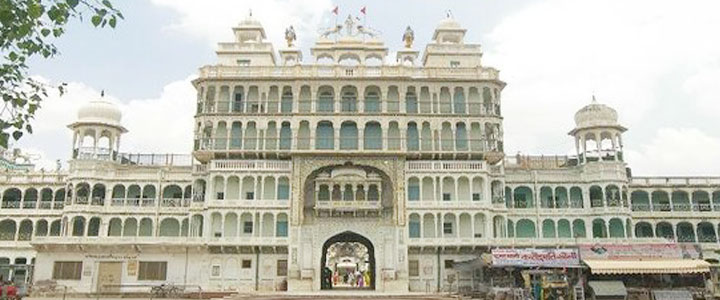About Us
The Marwari society from Rajasthan and other parts of country worship Rani Sati Dadi and they believe that Rani Sati Dadi is Maa Durga. Rani Sati Dadi is related to Mahabharata. She was Utera, wife of Abhimanyu. When Abhimanyu was died in the battle of Mahabharata by that time Utera wanted to be sati by putting her body into the funeral fire of Abhimanyu.

Sri Krishna came to her and advised her against it. He also gave her boon that it would only be possible in the next birth and her wish to become sati will be fulfilled.
In the next life her name was Narayani, daughter of Gursamal in the village of Thukaye in Rajasthan. Abhimanyu became Thandhan son of Jaliram at Hissar in his second life. Thandhan has a beautiful horse and used for his purpose. Thandhan got married to Narayani and spent his life nicely. One of the king's son from Hissar wished to take the beautiful horse of Thandhan but he denied to give the horse.
Finally the king's son decided to get the horse forcibly and fought with Thandhan. Thandhan killed the king's son. By getting the news of death of his son, king decided to kill the Thandhan. Thandhan died in front of Narayani in the battle while fighting with king. Narayani fought with the king and killed the king.
She ordered Ranaji who was the care taker of the horse, to make proper arrangement so that she can put herself in the fire with her husband. She blessed Ranaji that his name will be worshiped as Rana Sati with her name and since then she is called as Rani Sati. The blessing of Rani Sati Dadi is very powerful.
The location of her sacrifice is now marked with the memorial templae. She is now the family deity of the Agrawal marwaris hailing form the town (Tulsyans ,Jalans and Jhunjhunwalas).
Introduction to Rani Sati Temple
Jhunjhunu Shri Ranisati Mandir in Jhunjhunu has a history of more than 400 years and is a commanding testimony to feminine bravery and motherhood with rich tales of history that captivate the fancy of all tourists. Counted among the magnum opus temples of India, Ranisati Temple in Jhunjhunu is famous for its paintings. It is one of the earliest pilgrimages in the country. This imposing historic masterpiece is unparalleled in its appeal and is a delight to all eyes.
History of Rani Sati Temple, Jhunjhunu
Located in Jhunjhunu, Rani Sati temple in Jhunjhunu it is one of the magnificent temples in India. The temple enjoys the distinction of being one of the ancient pilgrimages in the country. The temple is a historic and unprecedented work of genius that warrants a special visit.
Description of Rani Sati Temple, Jhunjhunu
Billions of worshippers and followers, not only in India but worldwide too come visiting Jhunjhunu's Rani Sati Temple. Devotees from all over offer their prayers and puja everyday almost ritualistically. Jhunjhunu Rani Sati Temple is the epitome of secular thoughts of India as followers of Hindu, Muslim, Sikh, Christian, Jain follow and worship Shri Rani Satiji with equal piety, devotion and unwavering faith.
On the occasion of Bhado Amavasya or the no-moon day a sacred Pujanutsav is held in Jhunjhunu. Millions of devotees gather at the temple complex every year on this auspicious day and stand in queue to get a glimpse of the majestic Shri Rani Satiji. The most characteristic feature of Jhunjhunu Shri Rani Sati Temple is that there is no statue or image of any female or male Gods. A trident in the form of power and force is worshipped, which as per the Hindu religion, is the supreme might.
A splendid portrait of the Rani Satiji is located in the Pardhan Mand with the imposing Shikhar. The entire edifice in white marble is charming. The main Temple of Shri Rani Satiji is the place for the main sanctum sanctorum. The temple also boasts colorful wall paintings. The temple is graced with fine murals which bear the unmistakable imprint of bearing the brunt of time.


